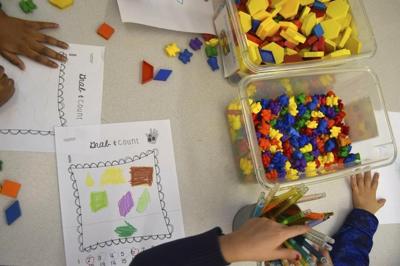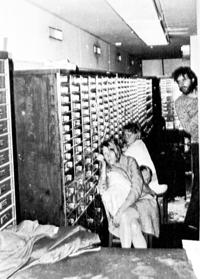Laura Jackson became seriously concerned about her daughter and math when the girl was in third grade. While many of her classmates flew through multiplication tests, Jackson’s daughter relied on her fingers to count, had difficulty reading clocks and burst into tears when asked at home to practice math flashcards.
At school, the 9-year-old had been receiving help from a math specialist for two years, with little improvement.
“We hit a point where she was asking me, ‘Mom, am I stupid?’” Jackson recalled.
One day, when having lunch with a friend, Jackson heard about a disorder known as dyscalculia. She later looked up a description of the learning disability that impacts a child’s ability to process numbers and retain math knowledge. “I was like, ‘Oh my gosh, this is my kid,’” Jackson said.
___
The , a coalition of eight newsrooms, is documenting the facing schools and . Join our live expert panel for families, “Solving The Math Problem,” at 8 p.m. Eastern on Tuesday, Oct. 17, at . Members of the Collaborative are , The Associated Press, The Christian Science Monitor, The Dallas Morning News, , Idaho Education News, The Post and Courier in South Carolina, and The Seattle Times.
___
Nationwide, hundreds of thousands of students face challenges due to disabilities like dyscalculia, a neurodevelopmental learning disorder caused by differences in parts of the brain that are involved with numbers and calculations. There are often obstacles to getting help.
America’s schools have long struggled to identify and support students with . Kids often languish while ; families frequently have to turn to private providers to get one; and even with a diagnosis, some schools are unable to provide children the help they need.
That’s slowly changing — for some disabilities. Most states have passed laws that mandate screening early elementary students for the most common reading disability, , and countless districts train teachers to . Meanwhile, parents and experts say schools neglect students with math disabilities like dyscalculia, which affects up to of the population and with dyslexia.
“There’s not as much research on math disorders or dyscalculia,” as there is on reading disabilities, said Karen Wilson, a clinical neuropsychologist who specializes in the assessment of children with learning differences. “That also trickles down into schools.”
Math scores in the U.S. have remained dismal for years and only . Learning struggles for some may be due to dyscalculia or other math learning disabilities, yet few teachers report their students have been screened for dyscalculia.
Experts say learning the most effective methods for teaching students with math disabilities could for all students.
“If it works for the students with the most severe disconnections and slower processing speeds, it’s still going to work for the kids that are in the ‘middle’ with math difficulties,” said Sandra Elliott, a former special education teacher and current chief academic officer at TouchMath, a multisensory math program.
Some signs of dyscalculia are obvious at an early age, if parents and educators . Young children might have difficulty recognizing numbers or patterns. In elementary school, students may have trouble with math functions like addition and subtraction, word problems, counting money or remembering directions.
Even after Jackson learned about dyscalculia on her own, her daughter’s Seattle-area public school was doubtful the third grader had a learning disability because she was performing well in other areas. Teachers suggested Jackson spend extra time on math at home.
“For so many parents, they assume the school would let them know there’s an issue, but that’s just not how it works,” said Jackson, who ultimately wrote a book, “Discovering Dyscalculia,” about her family’s journey.
Students with dyscalculia often need a more structured approach to learning math that involves “systematic and explicit” instruction, said Lynn Fuchs, a research professor in special education and human development at Vanderbilt University.
Part of the problem is that teachers don’t receive the training needed to work with children with math disabilities. At least one state, Virginia, requires dyslexia awareness training for teacher licensure renewal, but has no similar requirement for math disability training.
“It’s pretty rare for undergraduate degrees or even master’s degrees to focus on math learning disabilities with any level of breadth, depth, quality or rigor,” said Amelia Malone, director of research and innovation at the ��ɫtv Center for Learning Disabilities.
Without more widespread knowledge of and support for dyscalculia, many parents have had to look for specialists and tutors on their own, which they say can be particularly challenging for math, and costly. In 2019, Jackson started pulling her daughter out of school for part of each day to teach her math at home.
“I am not a math teacher, but I was so desperate,” Jackson said. “There’s no one who knows anything, and we have to figure this out.”
At the tutoring organization Made for Math, specialists have found children with dyscalculia need repetition, especially to understand math facts. Some students attend tutoring up to four days a week, at a cost of up to .
“It’s hard because it’s not something schools are offering, and kids deserve it,” said Heather Brand, a math specialist and operations manager for the organization.
There are pockets of progress around the country in screening more children for math disabilities, but movement at the federal level — and in most states — is “nonexistent,” said Malone, of the ��ɫtv Center for Learning Disabilities.
New York City is one district that has prioritized math disability screening and math instruction in the early years. In 2015 and 2016, the city spent $6 million to roll out a math curriculum featuring games, building blocks, art projects and songs. The district has also introduced universal math and reading screeners to try to identify students who may be behind.
There are ways that all schools can make math instruction more accessible, experts say. , activities that involve more senses should be used more widely, including whole-body motions and songs for teaching numbers and hands-on materials for math operations.
Jackson said her daughter could have benefited from a wider variety of methods at school. When the teen returned to school-based math classes in high school, after several years of learning math at home, she achieved an A in algebra.
“When you really understand what it is to be dyscalculic, then you can look around and decide what this person needs to succeed,” Jackson said. “It’s not just that you’re ‘bad at math’ and need to buckle down and try harder.”
___
The Associated Press education team receives support from the Carnegie Corporation of New York. The AP is solely responsible for all content.








































